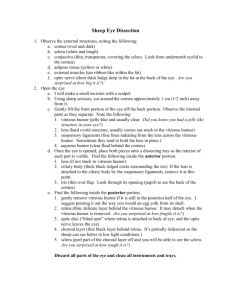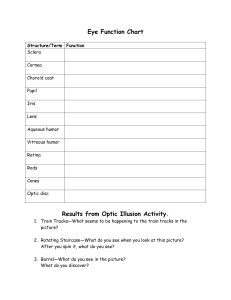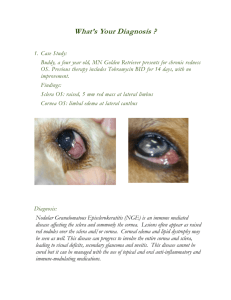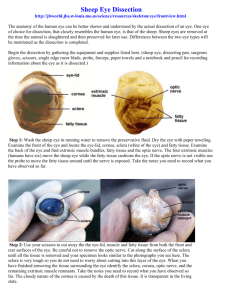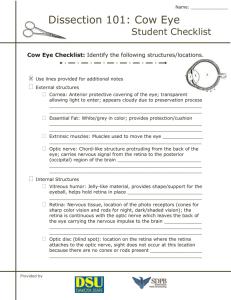Lab 8
advertisement
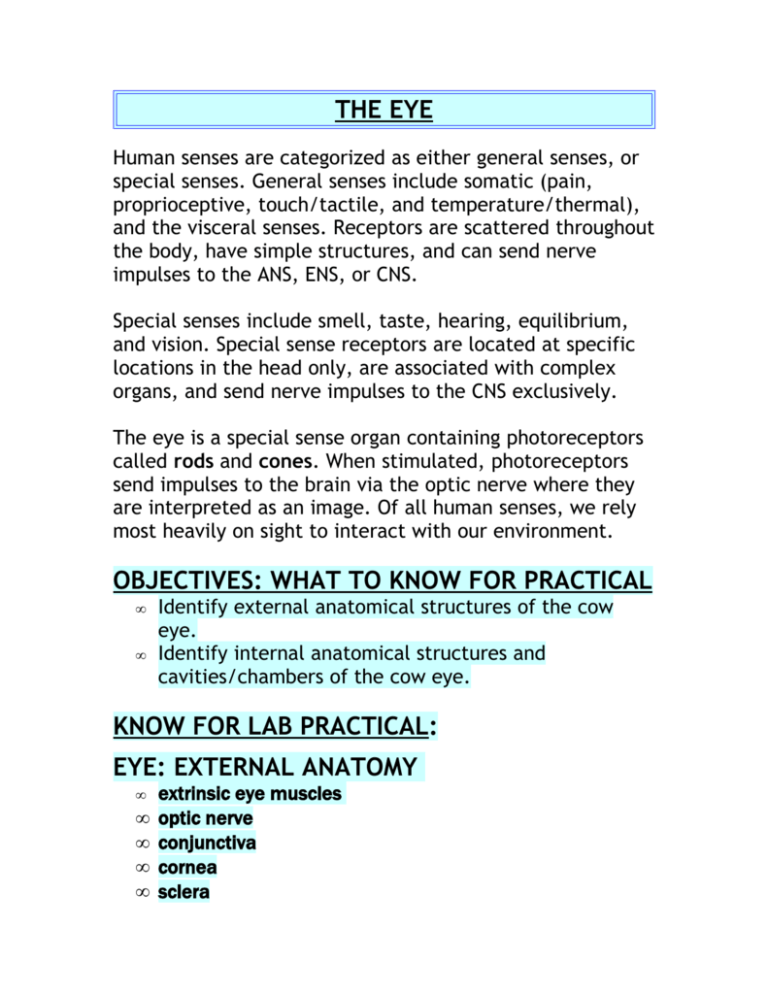
THE EYE Human senses are categorized as either general senses, or special senses. General senses include somatic (pain, proprioceptive, touch/tactile, and temperature/thermal), and the visceral senses. Receptors are scattered throughout the body, have simple structures, and can send nerve impulses to the ANS, ENS, or CNS. Special senses include smell, taste, hearing, equilibrium, and vision. Special sense receptors are located at specific locations in the head only, are associated with complex organs, and send nerve impulses to the CNS exclusively. The eye is a special sense organ containing photoreceptors called rods and cones. When stimulated, photoreceptors send impulses to the brain via the optic nerve where they are interpreted as an image. Of all human senses, we rely most heavily on sight to interact with our environment. OBJECTIVES: WHAT TO KNOW FOR PRACTICAL • • Identify external anatomical structures of the cow eye. Identify internal anatomical structures and cavities/chambers of the cow eye. KNOW FOR LAB PRACTICAL: EYE: EXTERNAL ANATOMY • • • • • extrinsic eye muscles optic nerve conjunctiva cornea sclera EYE: INTERNAL ANATOMY CAVITIES; CHAMBERS; HOLES • anterior cavity: internal space from lens to cornea; filled with a fluid called aqueous humor o anterior chamber: internal space from iris to cornea o posterior chamber: internal space from lens to iris • posterior cavity: internal space from retina to lens; filled with gelatinous vitreous body • pupil: hole in the iris STRUCTURES • cornea: first structure to focus light • iris: contaction/relaxation of its smooth muscle regulates diameter of the pupil • ciliary body and muscle • suspensory ligaments • lens: primary light focusing structure • retina: interior-most of the 3 eye layers o optic disc • vitreous body – not shown or labeled in photos • choroid: middle eye layer o tapetum lucidum – not found in human eye; irridescent silver-blue color • sclera: outer-most, thickest eye layer PROCEDURE • Consult the glossary in your text for pronunciation of structures. By this time, it should be second nature. REMEMBER: correct pronunciation will lead to correct spelling. Don’t be lazy; look it up! Follow the link below to: 2651 Laboratory Page http://www.valdosta.edu/~dodrobin/2651/2651Lab.htm • • On the drop-down menu to the left entitled Lab Study Aids, CLICK: Eye Review • Read the instructions along the left column. • You will work in pairs with the same lab partner with whom you studied the sheep brain. Take your jar over to a sink, remove the cow eye, and run water over the eye removing surface preservative; thus, decreasing odor in the lab. Immediately after removing the eye, tighten the lid on your jar securely so preservative will not be spilled if the jar is accidently dropped, or if it gets knocked off your lab table. There have been cases in the past where jars with un-tightened (or very loosely tightened) lids have been knocked to the floor, resulting in preservative splashing across the floor and on fellow students. • • EXTERNAL ANATOMY • • • Examine external anatomy of the cow eye. Identify the structures listed above. The conjunctiva is a thin, vascularized membrane attached directly to, and covering the cornea, and the portion of the sclera outside the eye orbit. Vasodilation of conjunctiva blood vessels results in “bloodshot” eyes. Inflammation of the conjunctiva is called “pink eye”, or more precisely, conjunctivitis. NOTICE: the cornea appears milky-colored and nearly opaque; in a live eye, the cornea is transparent. The cornea is composed of protein that becomes denatured and opaque when preserved. • There usually is a large amount of adipose tissue around the posterior portion of the eye. You may need to remove some fat so that the optic nerve is visible. DO NOT remove adipose tissue unless it is necessary; you can view all other external anatomical features without its removal. A greasy mess will result if you remove all fat. INTERNAL ANATOMY • • • • • • Place the eye in your dissecting pan, with the cornea facing upward. Hold the eye firmly against the pan. Keep your fingers out of harm’s way, apply direct downward force and puncture (to the inner cavity) the cow eye with a needle probe or one scissor blade approximately ½cm outside the cornea perimeter. (DO NOT use your scalpel or hold the eye in your hand). BE CAREFUL: it will take considerable pressure to puncture the sclera; it is thick, dense, and slick. Now use scissors; place one blade through the puncture and proceed to cut around the cornea completely at the same ½cm distance until you have separate anterior and posterior portions. The anterior portion will be a smaller portion of the eye than the posterior. Remove the lens that attaches to the ciliary body by tiny, difficult to see suspensory ligaments. Nonetheless, you can establish where they attach to the lens at a noticeable ridge around the lens. NOTICE: the lens is composed of protein that becomes opaque and denser as a result of denaturation from preservation. A live eye has a transparent lens, able to change shape from nearly • • • • spherical to ovoid as ciliary muscles contract and pull on suspensory ligaments. Pick up the posterior portion of the eye. Gently squeeze the sides to allow the gelatinous vitreous body to be extricated. The vitreous body is composed of protein (like the “white” of an egg) and normally transparent, but might be slightly opaque due to preservation. The vitreous body provides a medium through which light passes to be focused on retinal photoreceptors, and provides intraocular pressure needed to keep the retina pressed to the choroid. The retina is physically attached at a single point only - to the optic nerve. The attachment point is called the optic disc (“blind spot”) because it is the only location on the retina where there are no photoreceptors. The optic disc is recognized by a “puckered” appearance on the retina surface if it remains pressed against the choroid. The retina may collapse when the vitreous body is removed, but will remain attached at the optic disc. Examine other internal anatomy of the eye. Identify the structures, cavities, and hole listed above.



